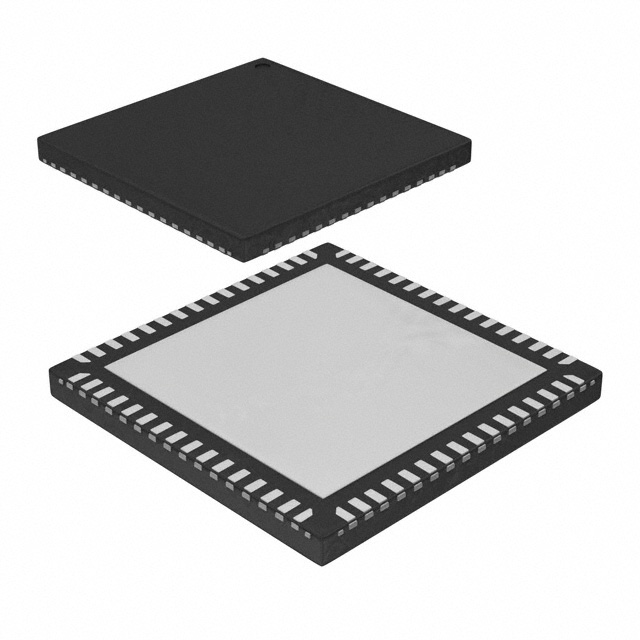Xem thông số kỹ thuật để biết chi tiết sản phẩm.

AT91SAM7S256C-MU
Product Overview
Category
AT91SAM7S256C-MU belongs to the category of microcontrollers.
Use
It is primarily used for embedded systems and applications that require a high-performance microcontroller.
Characteristics
- High-performance 32-bit ARM7TDMI-S RISC architecture
- Clock frequency up to 55 MHz
- 256KB Flash memory and 64KB SRAM
- Multiple communication interfaces (UART, SPI, I2C)
- Analog-to-Digital Converter (ADC) with multiple channels
- Real-Time Clock (RTC) with calendar and alarm functions
- Low power consumption
- Small form factor package
Package
AT91SAM7S256C-MU is available in a compact QFN package.
Essence
The essence of AT91SAM7S256C-MU lies in its powerful ARM7TDMI-S core, extensive memory, and versatile peripherals, making it suitable for a wide range of applications.
Packaging/Quantity
AT91SAM7S256C-MU is typically sold in reels or trays, with a quantity of 250 units per reel/tray.
Specifications
- Microcontroller: ARM7TDMI-S
- Clock Frequency: Up to 55 MHz
- Flash Memory: 256KB
- SRAM: 64KB
- Communication Interfaces: UART, SPI, I2C
- ADC Channels: Multiple
- RTC: Yes
- Power Consumption: Low
- Package: QFN
Detailed Pin Configuration
The detailed pin configuration of AT91SAM7S256C-MU can be found in the product datasheet.
Functional Features
- High-performance 32-bit RISC architecture for efficient processing
- Ample memory for storing program code and data
- Versatile communication interfaces for seamless connectivity
- Analog-to-Digital Converter for precise measurement and control
- Real-Time Clock for timekeeping and scheduling
- Low power consumption for energy-efficient operation
Advantages and Disadvantages
Advantages
- Powerful ARM7TDMI-S core for high-performance computing
- Extensive memory for storing large programs and data
- Versatile communication interfaces for seamless integration with other devices
- Analog-to-Digital Converter for accurate measurement and control
- Real-Time Clock for time-sensitive applications
- Low power consumption for energy efficiency
Disadvantages
- Limited processing power compared to more advanced microcontrollers
- Relatively small memory capacity compared to higher-end models
- Lack of advanced features found in newer microcontroller architectures
Working Principles
AT91SAM7S256C-MU operates based on the principles of the ARM7TDMI-S architecture. It executes instructions stored in its Flash memory, processes data using its RISC core, and communicates with external devices through its various interfaces. The microcontroller can be programmed using suitable development tools and software.
Detailed Application Field Plans
AT91SAM7S256C-MU finds applications in various fields, including but not limited to: - Industrial automation - Consumer electronics - Automotive systems - Medical devices - Internet of Things (IoT) devices - Robotics
Detailed and Complete Alternative Models
Some alternative models that offer similar functionality to AT91SAM7S256C-MU include: - STM32F407VG - PIC32MX795F512L - LPC1768
These models provide comparable features and performance, allowing users to choose the most suitable microcontroller for their specific application requirements.
Word count: 452 words
Liệt kê 10 câu hỏi và câu trả lời thường gặp liên quan đến ứng dụng AT91SAM7S256C-MU trong giải pháp kỹ thuật
Sure! Here are 10 common questions and answers related to the application of AT91SAM7S256C-MU in technical solutions:
Q: What is the AT91SAM7S256C-MU microcontroller used for? A: The AT91SAM7S256C-MU is a microcontroller commonly used in embedded systems for various applications, including industrial automation, consumer electronics, and IoT devices.
Q: What is the maximum clock frequency supported by the AT91SAM7S256C-MU? A: The AT91SAM7S256C-MU supports a maximum clock frequency of 55 MHz.
Q: How much flash memory does the AT91SAM7S256C-MU have? A: The AT91SAM7S256C-MU has 256 KB of flash memory for program storage.
Q: Can I expand the memory of the AT91SAM7S256C-MU? A: Yes, the AT91SAM7S256C-MU supports external memory expansion through its external bus interface.
Q: What peripherals are available on the AT91SAM7S256C-MU? A: The AT91SAM7S256C-MU includes various peripherals such as UART, SPI, I2C, ADC, PWM, and timers/counters.
Q: Does the AT91SAM7S256C-MU support USB connectivity? A: Yes, the AT91SAM7S256C-MU features a USB 2.0 full-speed device port.
Q: Can I use the AT91SAM7S256C-MU for real-time applications? A: Yes, the AT91SAM7S256C-MU offers real-time performance with its integrated ARM7TDMI-S core and advanced interrupt controller.
Q: What development tools are available for programming the AT91SAM7S256C-MU? A: There are various development tools available, including IDEs like Keil MDK, IAR Embedded Workbench, and open-source options like GCC and Eclipse.
Q: Is there a development board available for the AT91SAM7S256C-MU? A: Yes, Atmel provides development boards like the AT91SAM7S-EK and AT91SAM7S64-EK that are compatible with the AT91SAM7S256C-MU.
Q: Can I use the AT91SAM7S256C-MU in battery-powered applications? A: Yes, the AT91SAM7S256C-MU is designed to be power-efficient and can be used in battery-powered applications with proper power management techniques.
Please note that these answers are general and may vary depending on specific implementation details and requirements.

